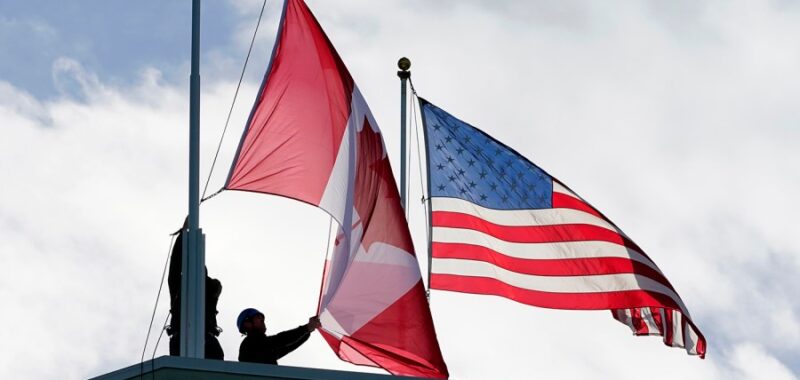
It was significant — and wise — that Canadian Prime Minister Mark Carney’s first trip abroad was to the United Kingdom and France.
Rather than focusing on Washington, Canada’s next elected prime minister, whether Carney or Conservative opposition leader Pierre Poilievre, should continue thinking generationally about Canada’s economic and security partnerships with Britain and Europe.
America under President Trump is withdrawing from its postwar global leadership role, but Europe is moving in precisely the opposite direction. Europe is getting much more serious on geopolitical risk management and national security. Meanwhile, Canada needs a more diversified portfolio of strategic friends and assets following the close of Pax Americana.
Two huge opportunities have arisen that could boost Canadian defense capability in tandem with Europe’s.
According to the Financial Times, the European Union intends to bulk purchase weapons, opening procurement exclusively to EU defence contractors and “those from third countries that have signed defence agreements with the [EU].” Additionally, according to Bloomberg, major European pensions are — in the spirit of better late than never — reviewing their Environmental, Social and Governance or ESG policies to enable investment in defense industries once again.
The former initiative alone represents nearly $900 billion in demand signal for British and European defense industries — why shouldn’t Canada be considered?
Canada already has the core building blocks in place to present an ambitious plan for Euro-Atlantic defense production during future Europe-Canada discussions. Under Prime Minister Stephen Harper, Canada developed the Canada-European Union free trade deal, known as CETA. Under Prime Minister Justin Trudeau, Canada launched a basic free trade agreement with the UK, with talks of expansion now back on the table.
As a next step, Canada could announce its intent to replicate our U.S. defense-industrial cooperation privileges with Britain and Europe, so that the EU and UK governments treat the Canadian defense industry as domestic and free from trade friction — with Canada reciprocating. Canada should also fast-track defense and security pact negotiations with the EU, leveraging relationships and processes built through CETA.
This would not simply serve Canada’s interests; Canada produces some of the most critical defense assets for Europe. This includes 155mm howitzer shells, for which global allied stockpiles have plummeted as the free world feeds Ukraine’s defensive efforts, along with light weapons platforms in common use by allied militaries across North America, Britain and Europe.
Not only that, but a potential pivot in Ottawa from the balance of its F-35 fighter jet order with the U.S. to a European fighter to replace the Royal Canadian Air Force’s fleet of aging CF-18s – a move officially under consideration by the governing Liberals – could sweeten the deal even further.
This rebalancing of Canada’s North Atlantic security relationships should not be seen as merely a kneejerk reaction to President Trump’s trade war provocations. Frankly, diversifying Canada’s trade and defense posture is run-of-the-mill geostrategic housekeeping that Canada should have been more serious about decades ago. The nation’s “concentration risk,” in terms of outright dependency on the U.S. in both spheres, is very high.
Historically, the quid pro quo for American security guarantees is a commitment by American allies to buy from U.S. defense companies. Without that financial pull toward U.S. industry, global defense investment patterns are rebalancing toward Europe. Without over-correcting, and while clearly remaining in the Western sphere for purchases and technology integration, Canada should tilt its defense industrial base to where the puck is going.
Canada’s recently announced partnership with Australia on Over-the-Horizon Radar technology for deployment in the Canadian Arctic may prove a template for future procurement and partnership. This collaboration on key technology demonstrates Canada’s solid intent to remain within the U.S. sphere of influence (Australia is a key partner in the AUKUS nuclear submarine procurement), protects an area of vital interest to both the United States and Canada, and deftly balances the need to develop alternative bilateral partnerships for defense and technology procurement.
By working with the Europeans to create powerful new procurement architecture for pressing defense concerns, Canada’s next prime minister could do more for its domestic military-industrial base than any prime minister in living memory.
Importantly, there is a historical symmetry to this moment. In World War II, Canada served as the armory of the allies, producing small arms, artillery and vehicles for the allied war effort in Europe, owing in part to our still-relevant geographic insulation from the war. Lee-Enfield rifles protected British Commonwealth forces, while Colt pistols sat upon many allied hips. Canada produced 800,000 military vehicles for the effort, while “bomb girls” across Ontario helped Canadians and our allies march toward Germany with the munitions needed for victory.
In spite of the clear near-term tensions, the Canada-U.S. relationship will remain the most important defense relationship for both countries. It is in each country’s best interest that Canada take measures to serve European allies and to build more links with aligned countries on a basis of technology sharing and defense.
Ultimately, the U.S. seeks a reliable, well-resourced ally to defend against Chinese and Russian incursion in the continent’s northern reaches, while Canada seeks to maintain confidence and influence in organizations such as NORAD. Anticipating the country can indeed find success in meeting European needs, a Canadian industry actively serving and pursuing defense and technology collaboration with Asian allies such as Japan, the Republic of Korea and Taiwan could also help Washington understand Canada’s value.
The opportunity for Canada to partner in Europe’s rearmament may prove fleeting, as Europe looks to rearm quickly. If Canada’s next prime minister wants to signal serious Canadian leadership on the world stage and trade diversification in the near term, another trip to Europe should occur shortly after an anticipated Canadian federal election.
Mark Lawson, a former deputy chief of staff to Ontario Premier Doug Ford, is an
independent consultant based in Toronto. Matthew Bondy is a senior fellow with the Macdonald-Laurier Institute and the Center for North American Prosperity and Security and the founder of Bondy & Associates.

